Solar charging for lithium battery
“I blinded him from what was” (c) Tanich M.
My good old friend is a water tourist. Once upon a time, back in the last century, as my son says, I presented a friend with a solar battery for charging camcorder batteries.
Then I bought in Chip and Dip heels of solar cells of domestic production, connected them in series, added the KD213 diode. The result was a battery with a voltage of about 9 volts and a current of about 300 mA. Mechanically, the battery cells were connected by strips of blue electrical tape, the battery was folded accordion, my friend made a homemade cover for it. Since then, about 15 years have passed, this battery has been hiking many times and with constant success has charged a variety of Ni-Cd batteries.

It is now fashionable to use lithium power sources for both photo and video devices and for LED lights. Everything is cool, but lithium cells require careful handling - they must be carefully charged to a voltage of 4.2 volts, discharged to a certain voltage, otherwise you can permanently damage the battery or start a fire.
On a camping trip, my friend takes a headlamp on 18650 batteries. There is no charging mechanism in such a flashlight, so he asked me to come up with how to charge these elements in camping conditions. Along the way, there is a task to recharge smartphones and other gadgets.
I studied the offers on Ebay.com, found a curious device - a battery with a capacity of 10,000 mAh, in one case with a solar battery and electronics that control the charge-discharge of the battery and provide voltage of 5 volts on two USB connectors with a current of up to 2A. The price of 1000 r seemed adequate, the device was ordered. Device name: Solar Panel Power Bank Charger Battery for Mobile Samsung Iphone5s HTC 10000mAh
I also found charging for the 18650, which consists of an excellent case-holder and a built-in USB charging controller. It cost about 80 p. This item is called the New USB 18650 Battery Function Charger.
The initial idea was that on a sunny day, the Power bank charged the internal battery, and then gave out energy at 18650 through charging.
Pretty quickly both devices came from China and I started to study them. Charging for the 18650 did not bring any surprises - an excellent case, it charges the 18650 with a capacity of 2400 mAh from a USB port with a current of about 300 mA.
But PowerBank turned out to be defective. I measured its capacity by the method of complete discharge by direct current of about 300 mA - it turned out to be 1200 mAh. With the claimed 10,000 mAh - a hoax.
However, the case was made very soundly! Metal covers, everything is fitted, in the hands it feels as a whole. I decided to take it apart and see what's inside.
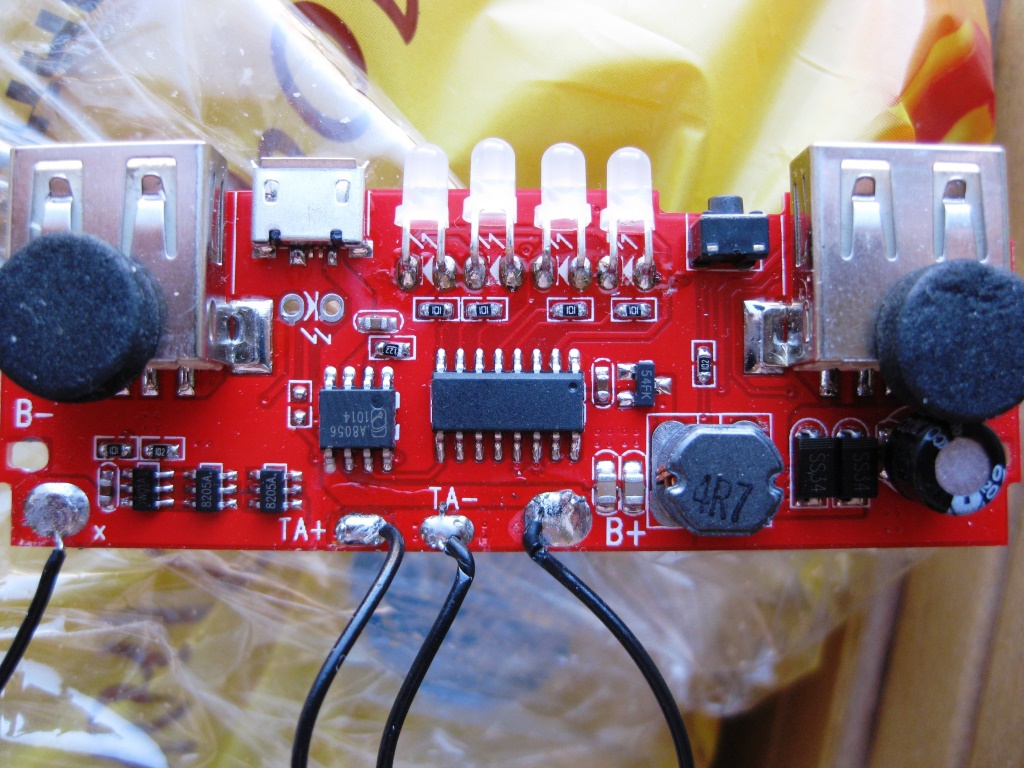

Inside was quite high-quality electronics - a lithium cell charging controller board, combined with a 5 volt 2 A stabilizer converter. It was not possible to install all types of microcircuits, but the impression was that the board was made for a multi-cell lithium battery with individual charge-discharge control of each element. However, all this wealth was left unused; lithium cells are simply connected in parallel. By the way, the soldering of this battery fell apart literally from a touch with a soldering iron ... Then I looked at the elements separately - IMHO a frank marriage ...
The 5-volt converter is made on a modern microcircuit operating at a frequency of 500 kHz.
Along the way, I measured the maximum output current - it turned out 1.6A. With the declared 2A - it is quite adequate.
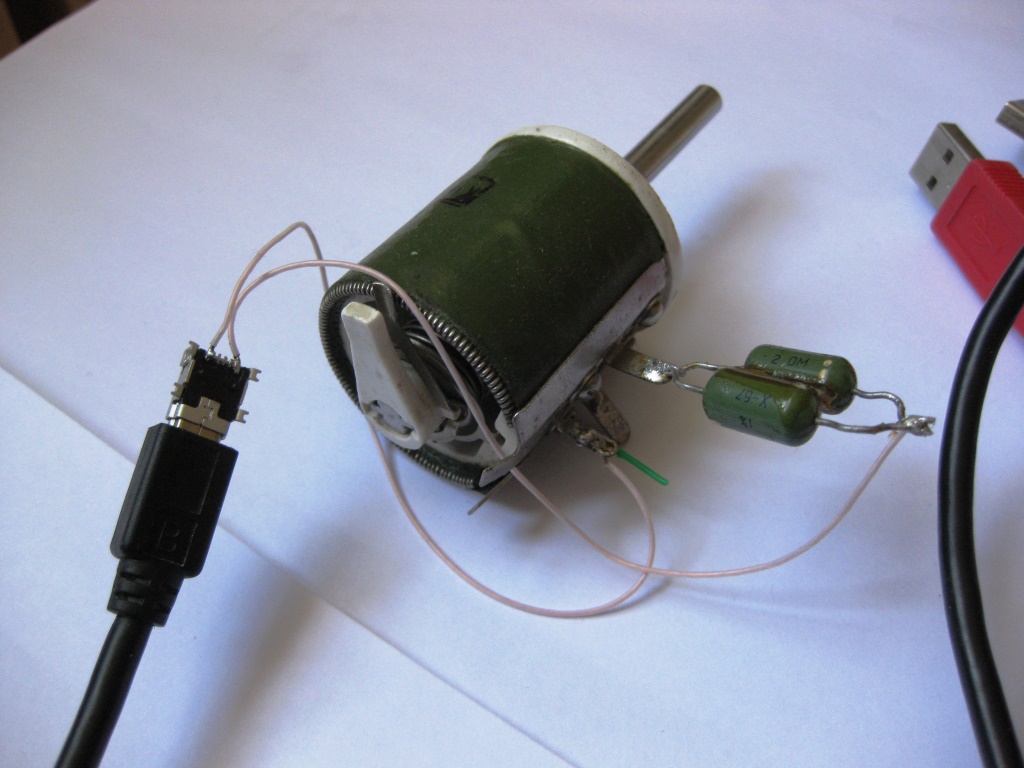
The photo shows the discharge circuit. A 33-ohm variable wire resistor, two parallel-connected 2-ohm resistors (1 ohm total) to control the discharge current.
Since there is a 5V stabilizer in PowerBank, it is enough to set the current consumption once at the beginning of the experiment.
Also on the board there is an LED indicator of the battery charge level, working both in the discharge mode and in the charging mode. As usual - bright blue “tear out the eyes” of color.
In general, everything is fine, except for the battery.
I wrote to the seller, demanded that part of the money be returned for the defective battery. The seller tried to confuse me with an allegedly incorrect method of measuring capacity - they say I did not take into account the loss, but after my second letter, where I put everything on the shelves, I returned a part of the money.
Since I disassembled PowerBank, I decided to try how it will work with the 18650 and the old solar battery. The results of the full-scale experiment turned out to be quite encouraging: the controller worked absolutely fine with the 18650, and the solar battery 15 years ago provided a charging current of about 370 mA. The measurement was carried out in Moscow on March 10. I believe that the summer sun will give an even greater charge current.
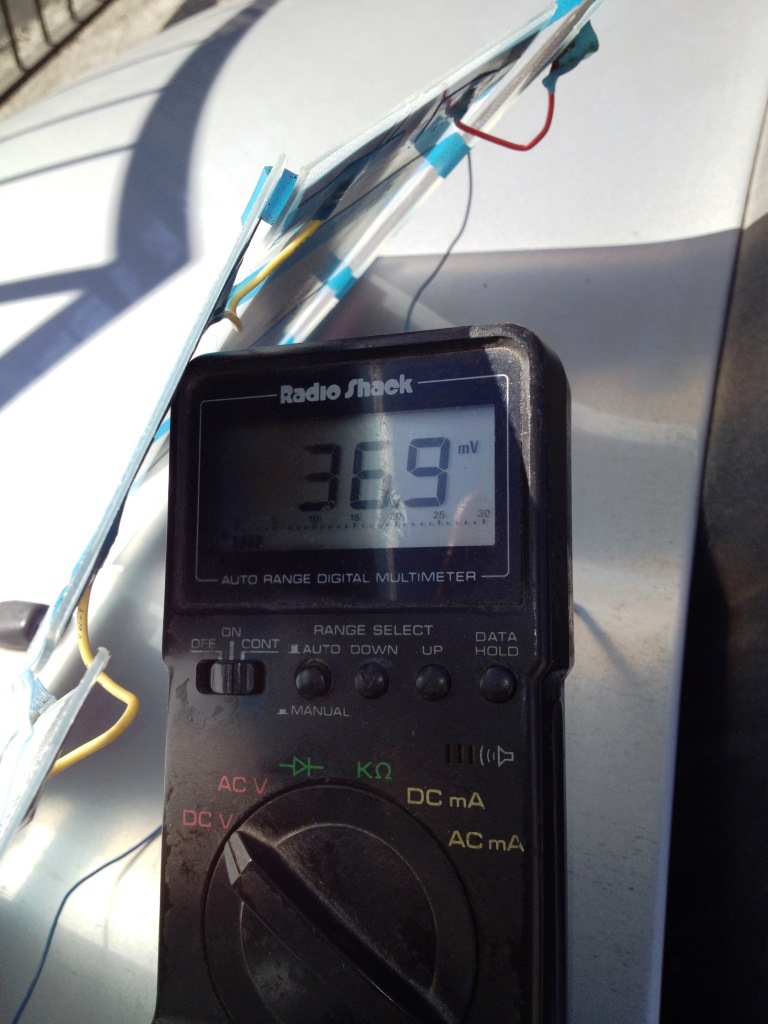
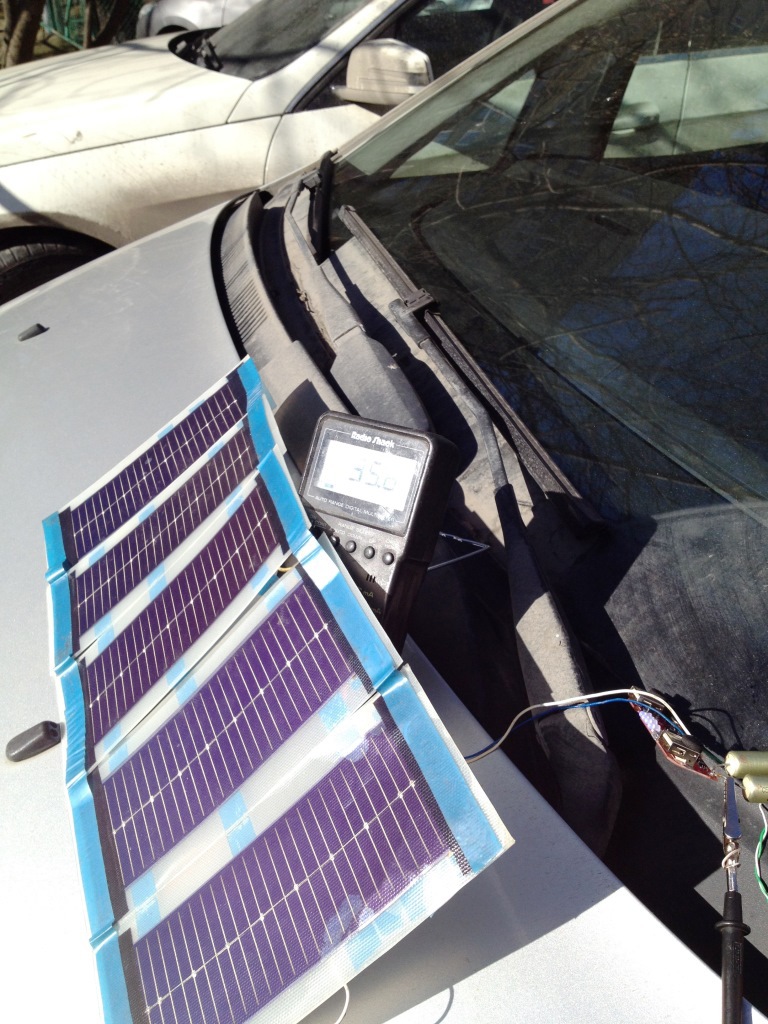
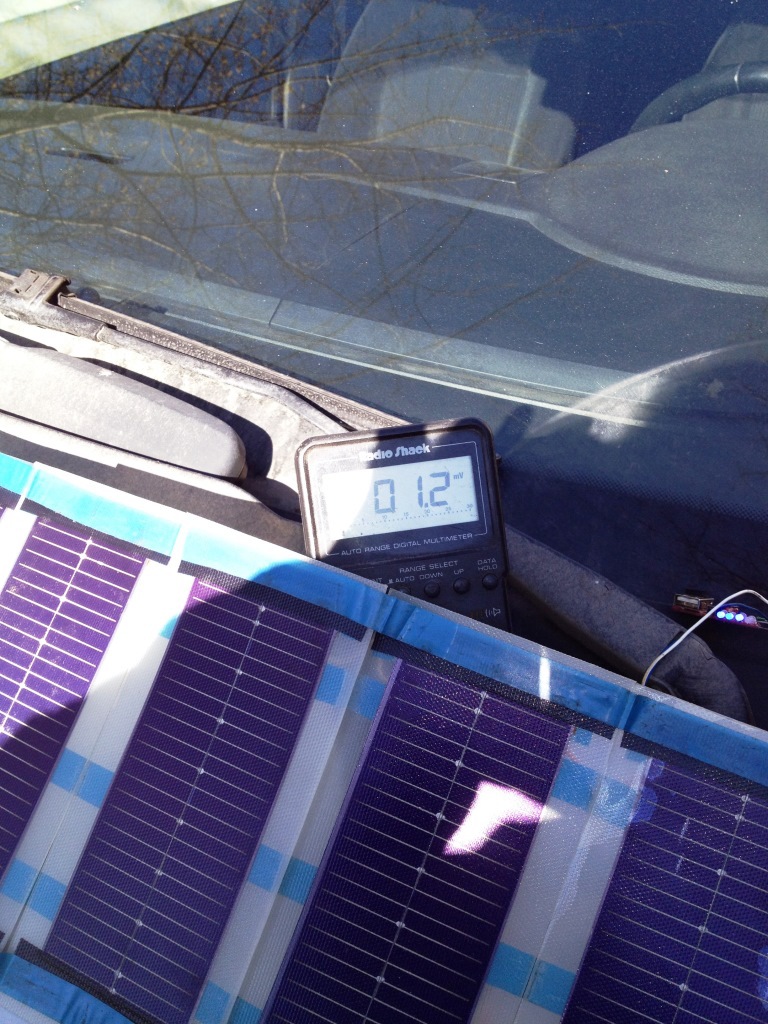
The charge-discharge current was measured by installing a 0.1 ohm resistor in series in the battery circuit. The 0.1 ohm resistor in my case consisted of two 0.2 ohms connected in parallel. A multimeter measured the voltage drop across this resistor. The current was converted from millivolts to milliamps by multiplying by 10.
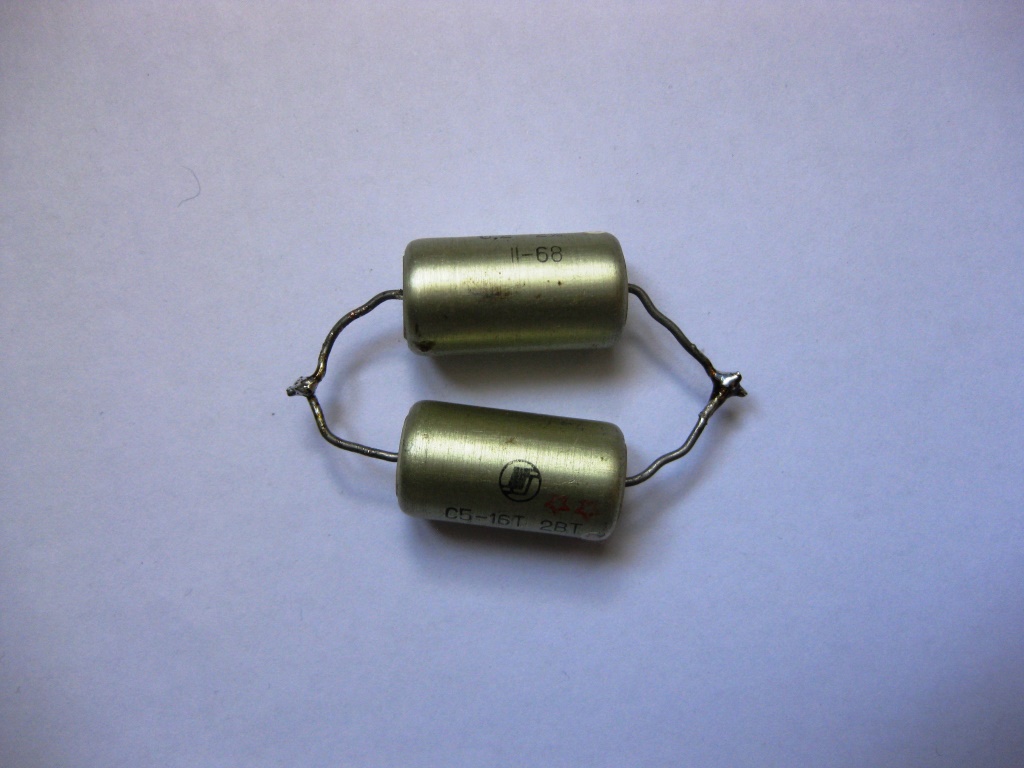
He measured the current given by the native solar cell - it turned out to be significantly lower, however, it was quite expected - the surface area is much smaller.
Thus, the optimal design began to look like a holder for the 18650, a cut-off case with a board and a separately connected solar battery. There is a pin connector on the 18650 holder, I cut off the counterpart from the USB connector and soldered it to the solar panel. 4 wires come out of the 18650 holder - two from the battery itself and two from the solar cell. This time, electrical tape was used in black, blue lasted 20 years and is in excellent condition, let's see how black behaves.
A couple of hours with a dremel, a drill and a pair of scissors gave me this design:

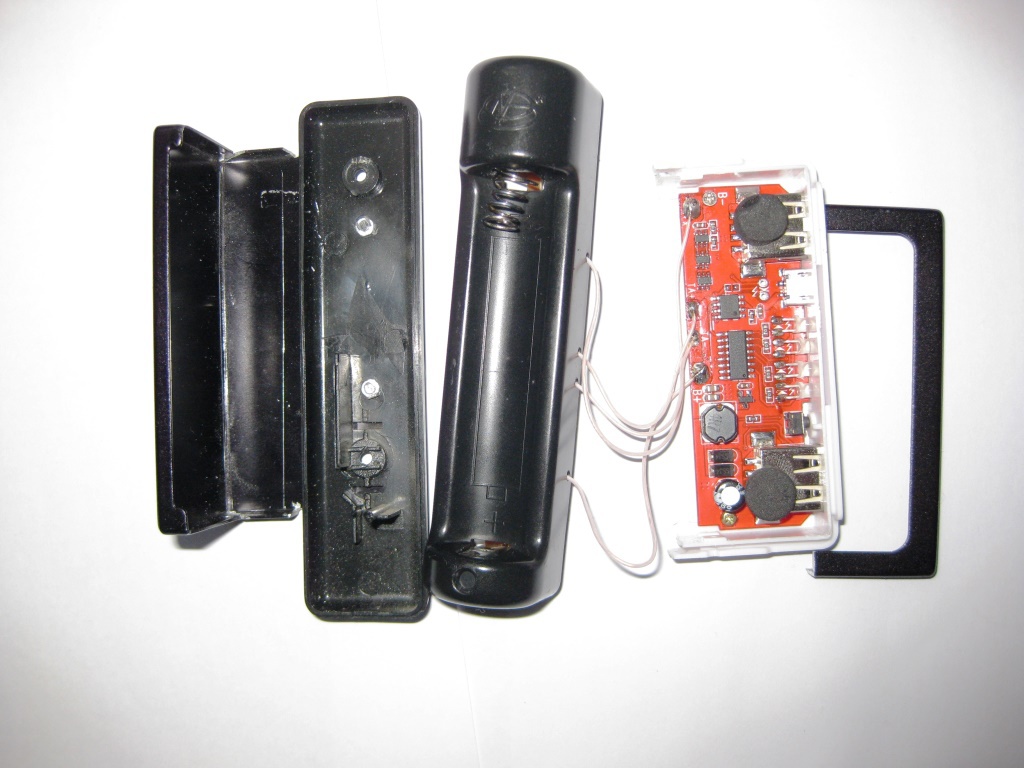
Fully assembled:

It turned out a system that can charge 18650 from a source of 5 volts (USB) and a solar battery, can give stable 5 volts to charge a variety of gadgets, fortunately, several PowerBanks were included in the PowerBank kit. A glitch was revealed - if the device has been without a battery for a long time - it does not turn on from the button. It turned out that the glitch is bypassed if you remove and insert the battery once or twice.
Now this device will be tested in the next trip to the Eastern or Western Sayan Mountains or to some other exotic place in Russia.
My good old friend is a water tourist. Once upon a time, back in the last century, as my son says, I presented a friend with a solar battery for charging camcorder batteries.
Then I bought in Chip and Dip heels of solar cells of domestic production, connected them in series, added the KD213 diode. The result was a battery with a voltage of about 9 volts and a current of about 300 mA. Mechanically, the battery cells were connected by strips of blue electrical tape, the battery was folded accordion, my friend made a homemade cover for it. Since then, about 15 years have passed, this battery has been hiking many times and with constant success has charged a variety of Ni-Cd batteries.

It is now fashionable to use lithium power sources for both photo and video devices and for LED lights. Everything is cool, but lithium cells require careful handling - they must be carefully charged to a voltage of 4.2 volts, discharged to a certain voltage, otherwise you can permanently damage the battery or start a fire.
On a camping trip, my friend takes a headlamp on 18650 batteries. There is no charging mechanism in such a flashlight, so he asked me to come up with how to charge these elements in camping conditions. Along the way, there is a task to recharge smartphones and other gadgets.
I studied the offers on Ebay.com, found a curious device - a battery with a capacity of 10,000 mAh, in one case with a solar battery and electronics that control the charge-discharge of the battery and provide voltage of 5 volts on two USB connectors with a current of up to 2A. The price of 1000 r seemed adequate, the device was ordered. Device name: Solar Panel Power Bank Charger Battery for Mobile Samsung Iphone5s HTC 10000mAh
I also found charging for the 18650, which consists of an excellent case-holder and a built-in USB charging controller. It cost about 80 p. This item is called the New USB 18650 Battery Function Charger.
The initial idea was that on a sunny day, the Power bank charged the internal battery, and then gave out energy at 18650 through charging.
Pretty quickly both devices came from China and I started to study them. Charging for the 18650 did not bring any surprises - an excellent case, it charges the 18650 with a capacity of 2400 mAh from a USB port with a current of about 300 mA.
But PowerBank turned out to be defective. I measured its capacity by the method of complete discharge by direct current of about 300 mA - it turned out to be 1200 mAh. With the claimed 10,000 mAh - a hoax.
However, the case was made very soundly! Metal covers, everything is fitted, in the hands it feels as a whole. I decided to take it apart and see what's inside.


Inside was quite high-quality electronics - a lithium cell charging controller board, combined with a 5 volt 2 A stabilizer converter. It was not possible to install all types of microcircuits, but the impression was that the board was made for a multi-cell lithium battery with individual charge-discharge control of each element. However, all this wealth was left unused; lithium cells are simply connected in parallel. By the way, the soldering of this battery fell apart literally from a touch with a soldering iron ... Then I looked at the elements separately - IMHO a frank marriage ...
The 5-volt converter is made on a modern microcircuit operating at a frequency of 500 kHz.
Along the way, I measured the maximum output current - it turned out 1.6A. With the declared 2A - it is quite adequate.

The photo shows the discharge circuit. A 33-ohm variable wire resistor, two parallel-connected 2-ohm resistors (1 ohm total) to control the discharge current.
Since there is a 5V stabilizer in PowerBank, it is enough to set the current consumption once at the beginning of the experiment.
Also on the board there is an LED indicator of the battery charge level, working both in the discharge mode and in the charging mode. As usual - bright blue “tear out the eyes” of color.
In general, everything is fine, except for the battery.
I wrote to the seller, demanded that part of the money be returned for the defective battery. The seller tried to confuse me with an allegedly incorrect method of measuring capacity - they say I did not take into account the loss, but after my second letter, where I put everything on the shelves, I returned a part of the money.
Since I disassembled PowerBank, I decided to try how it will work with the 18650 and the old solar battery. The results of the full-scale experiment turned out to be quite encouraging: the controller worked absolutely fine with the 18650, and the solar battery 15 years ago provided a charging current of about 370 mA. The measurement was carried out in Moscow on March 10. I believe that the summer sun will give an even greater charge current.



The charge-discharge current was measured by installing a 0.1 ohm resistor in series in the battery circuit. The 0.1 ohm resistor in my case consisted of two 0.2 ohms connected in parallel. A multimeter measured the voltage drop across this resistor. The current was converted from millivolts to milliamps by multiplying by 10.

He measured the current given by the native solar cell - it turned out to be significantly lower, however, it was quite expected - the surface area is much smaller.
Thus, the optimal design began to look like a holder for the 18650, a cut-off case with a board and a separately connected solar battery. There is a pin connector on the 18650 holder, I cut off the counterpart from the USB connector and soldered it to the solar panel. 4 wires come out of the 18650 holder - two from the battery itself and two from the solar cell. This time, electrical tape was used in black, blue lasted 20 years and is in excellent condition, let's see how black behaves.
A couple of hours with a dremel, a drill and a pair of scissors gave me this design:


Fully assembled:

It turned out a system that can charge 18650 from a source of 5 volts (USB) and a solar battery, can give stable 5 volts to charge a variety of gadgets, fortunately, several PowerBanks were included in the PowerBank kit. A glitch was revealed - if the device has been without a battery for a long time - it does not turn on from the button. It turned out that the glitch is bypassed if you remove and insert the battery once or twice.
Now this device will be tested in the next trip to the Eastern or Western Sayan Mountains or to some other exotic place in Russia.
